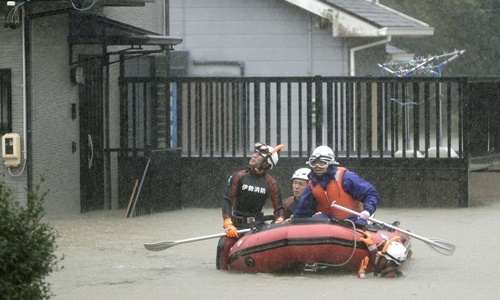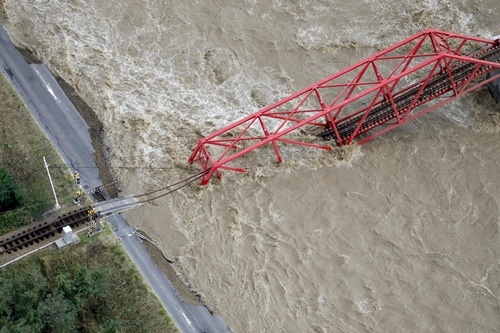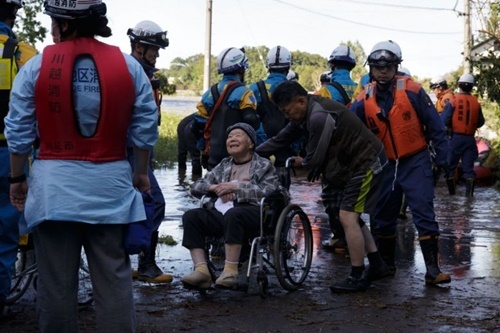In order to minimize damage, the authorities must constantly make recommendations before the storm returns. Saving people is always a priority.
When Typhoon Hagibis hit Japan on the evening of October 12, a record rainfall poured down, killing 77 rivers and killing at least 35 people. Even large urban centers suffer serious losses.

Rescuers ride a rubber boat in search of people still trapped in houses in Ise City, Mie Prefecture Photo: Reuters
In severe circumstances, dramatic rescues took place in a number of hotspots severely devastated by the storm, stranded residents dragged off the roof by helicopter or taken to the site. Deep flooded by lifeboats.
In Kawagoe, a city of about 350,000 people on the banks of the Oppegawa River in Saitama Prefecture, the river overflows, causing a series of residential areas. Inside the Kings Garden nursing home, the water level rose rapidly during the night, leaving 120 people unable to evacuate.
Rescue efforts cost a lot of manpower because each person from the nursing home is only transported on a rescue boat and up to 4 search and rescue personnel accompany. When they arrived in the dry area, the rescuers continued carrying the rescued people, who were frightened old men and women, taking the final steps to a safe place. Immediately, the volunteers lined up in a wheelchair to cover the victims and served them warmly.
Heavy flooding, even in high-lying urban areas, originates from the broken river dyke. Nagano City, the capital of Nagano Prefecture, which hosted the 1998 Winter Olympics, was engulfed in muddy water when the dyke on the Chikuma River broke. A hospital in Setagaya, a wealthy district in Tokyo, was also inundated.
In Kawasaki, an industrial city between Tokyo and Yokohama, 900,000 residents received evacuation requests. In Fukushima, which suffered as a result of a nuclear leak from a nuclear power plant during the 2011 earthquake and tsunami, households in some places were isolated by floodwaters.
The volunteers urgently supported the city of Kawagoe, about 48 km from central Tokyo. "This is the first time I've seen things like this," said Kosuke Yanagawa, 34, a nurse from Saitama, who volunteered to support the Kings Garden nursing home after watching the video of the rescue effort. television, said. "What is surprising is that floods also affect urban areas."
Kimiko Oda, 87, said she could not take a nap because the torrential rain rained down on the roof of the nursing home and the water rose quickly, causing them to rush to the second floor for the rescue team to arrive.
"Things are scary because I don't know what's going on," Oda said, adding that the only time she felt so scared was during World War II.

A railway bridge collapsed in Ueda, central Japan Photo: Reuters
Japanese authorities will take days to calculate the total damage caused by Typhoon Hagibis, but by October 13, Japanese media reported that at least 35 people were killed, 100 were injured, 15 were missing. .
About 27,000 rescuers are actively helping people evacuate from flooded areas in the provinces, including Fukushima, Kanagawa, Nagano, Saitama and Tokyo.
In Kawagoe, firefighters and police in orange outfits slowly drove small boats through flooded rice fields and residential areas in search of trapped people.
When the storm hit, the crowded railway stations and streets in Tokyo became deserted, uninhibited because before that, the authorities had advised people to stay indoors. About 17,000 police officers and soldiers received orders to take part in rescue missions at any time.
Evacuation centers have been set up in coastal cities and towns to provide shelter for tens of thousands of people. Kyodo News said the evacuation warning had been issued to more than 6 million people.
To raise public awareness, authorities repeatedly warned that Hagibis was as devastating as the storm that hit Tokyo in 1958, killing 1,200 people and half a million homes flooding.
The Japanese government this morning announced that search and rescue operations have been urgently carried out. Authorities are committed to improving facilities at evacuation centers and shelters without waiting for requests from local authorities.
Last night, Japanese Prime Minister Shinzo Abe attended a meeting with a task force set up to deal with the disaster. He affirmed rescuing people is the most important task.

An elderly woman was rescued from a flooded nursing home in Kawagoe City on October 13 Photo: NYTimes
In addition, the government is committed to updating the storm situation accurately every hour for the people. Special teams were sent to Miyagi, Fukushima, Saitama, Ibaraki, Tochigi and Nagano prefectures to closely monitor the situation and collect damage information.
In heavily flooded areas, people, who have been used to flooding in the past, also feel surprised. Yasuyuki Tamura, 52, a resident of Kawaoe, thought it was not necessary for him to evacuate from the place he had lived for most of his life before the storm.
In previous storms, water only flooded the entrance to Tamura's two-story house. But on the night of 12/10, the water rose incessantly. "I underestimated the storm and thought it would be okay," Tamura said. He was rescued yesterday morning and was evacuated at a gym in a local elementary school.
Tamura said he was not sure when he could return home because the country had not yet withdrawn. His insurance policy may have been washed away. "I never imagined the water would rise so fast and so high," he said.
At another nearby elementary school, life was still going on, the students still enthusiastically participating in a soccer match that had been scheduled in advance. Kiyoshi Odaka, 45, silently watched the 12-year-old son play football from the edge of the field. He evacuated his family from his home in Kawagoe from the afternoon of October 12. Odaka was also unable to return to check the damage, because according to what he saw on television, the water still flooded his neck. He lamented that he did not pay more attention to the risks of buying a home 7 years ago in an area very near the river, which is prone to flooding.
"I never thought such a disaster would happen," Odaka said, adding that he hoped the government would have stricter zoning regulations to prevent housing development in vulnerable communities. ear.
"It seems that I was too optimistic and trusted the government," he said. "It's a waste of money when the authorities have to mobilize helicopters for rescue missions and city officials who should be off work by the end of the week have to work. Building houses in areas like that. This is really a waste of money ".



 JasmineBell
JasmineBell







